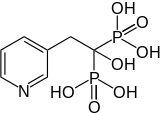Risedronic acid
 | |
| Clinical data | |
|---|---|
| AHFS/Drugs.com | International Drug Names |
| Pregnancy category | |
| Routes of administration | Oral |
| ATC code | |
| Legal status | |
| Legal status | |
| Pharmacokinetic data | |
| Bioavailability | 0.63% |
| Protein binding | ~24% |
| Metabolism | None |
| Biological half-life | 1.5 h |
| Excretion | Renal and fecal |
| Identifiers | |
| |
| CAS Number | |
| PubChem CID | |
| IUPHAR/BPS | |
| DrugBank | |
| ChemSpider | |
| UNII | |
| ChEMBL | |
| ECHA InfoCard | 100.116.436 |
| Chemical and physical data | |
| Formula | C7H11NO7P2 |
| Molar mass | 283.112 g/mol |
| 3D model (JSmol) | |
| |
| |
| | |
Risedronic acid (INN) often used as its sodium salt risedronate sodium (USAN) is a bisphosphonate used to strengthen bone, treat or prevent osteoporosis, and treat Paget's disease of bone. It is produced and marketed by Warner Chilcott, Sanofi-Aventis, and in Japan by Takeda under the trade names Actonel, Atelvia, and Benet. It is also available in a preparation that includes a calcium carbonate supplement, as Actonel with Calcium.
Administration
Risedronate is taken orally, usually weekly or monthly. Notably, if risedronate lodges in the esophagus, it can lead to esophageal ulcers. Therefore, it is recommended that risedronate be taken with the body upright, and followed by a glass of water. Moreover, risedronate is poorly absorbed when taken with food, so it is recommended that no food or drink other than water be taken for 2 hours before and 30 minutes after taking risedronate. Risedronate has a faster esophageal transit time and different chemical chain which results in less gastrointestinal side-effects than other drugs in this class. The dosage instructions also show that risedronate can be taken with less water than other drugs in the class. Risedronate is also available as a 75 mg tablet to be taken on two consecutive days each month (2CDM) in order to optimize patient adherence. This formulation has been studied in a randomized, double-blind, parallel-group, multinational trial in 1229 postmenopausal women with osteoporosis.[1]
Controversies
In January 2006 P&G and its marketing partner Sanofi-Aventis filed a Lanham Act false claims lawsuit against rival drugmakers Roche and GlaxoSmithKline claiming false advertising about Boniva.[2] The manufacturers of Boniva, a rival bisphosphonate, were accused in the suit of causing a "serious public health risk" through misrepresentation of scientific findings. In a ruling on September 7, 2006 U.S. District Judge Paul A. Crotty rejected P&G's attempted injunction. P&G was criticized for attempting to "preserve its market share by denigrating Boniva". Judge Crotty wrote that "Roche was clearly entitled to respond with its own data, provided that the data was truthfully and accurately presented".[3]
In 2006, P&G faced controversy over its handling of clinical research involving risedronate (News Reports[4] and discussion).[5]
In common with other bisphosphonate drugs, risedronate appears to be associated with the rare side effect osteonecrosis of the jaw, often preceded by dental procedures inducing trauma to the bone.
See also
References
- ↑ Frampton JE. Risedronate on Two Consecutive Days per Month : Drugs & Aging. Drugs&Aging 2009; 26(4):355-362. doi:10.2165/00002512-200926040-00006.
- ↑ "P&G Press statement". Uk.pg.com. Retrieved 2013-03-01.
- ↑ NY fed judge finds promotions for bone drug Boniva are fair Associated Press, 7 Sept 2006
- ↑ http://www.thejabberwock.org/wiki/index.php?title=Actonel_Case_Media_Reports
- ↑ "Scientific Misconduct Blog". Scientific-misconduct.blogspot.com. Retrieved 2013-03-01.